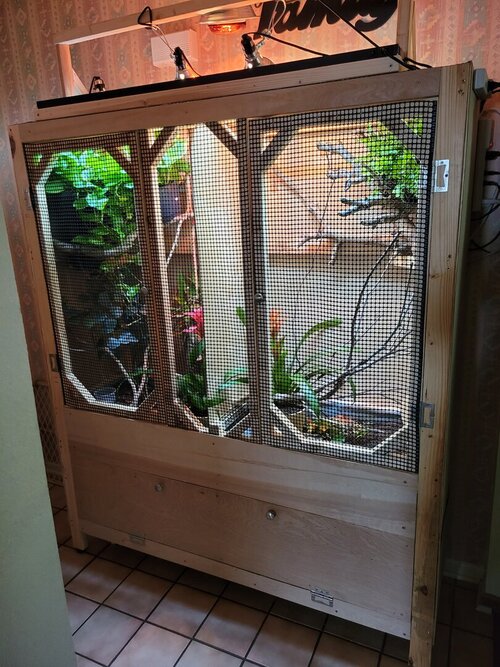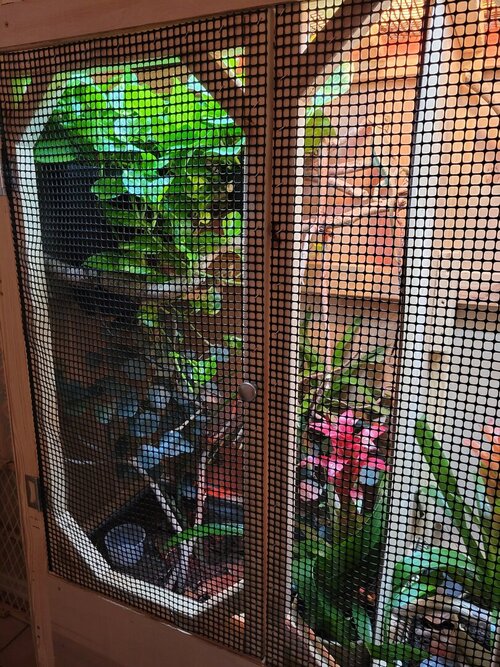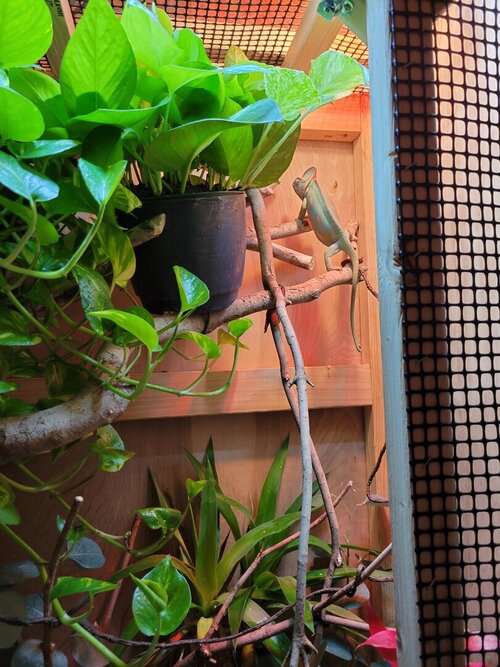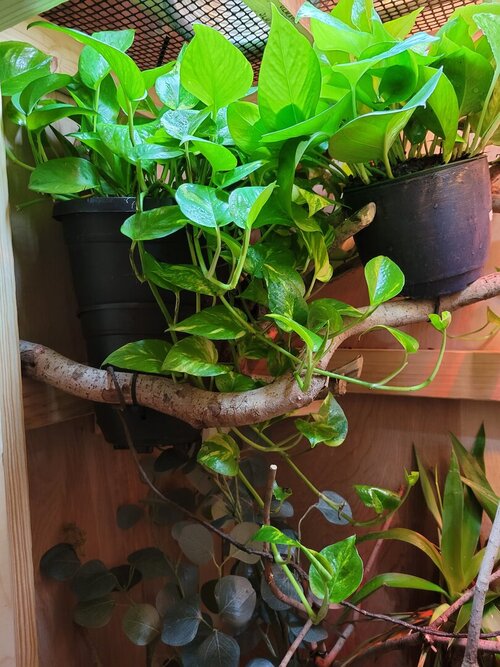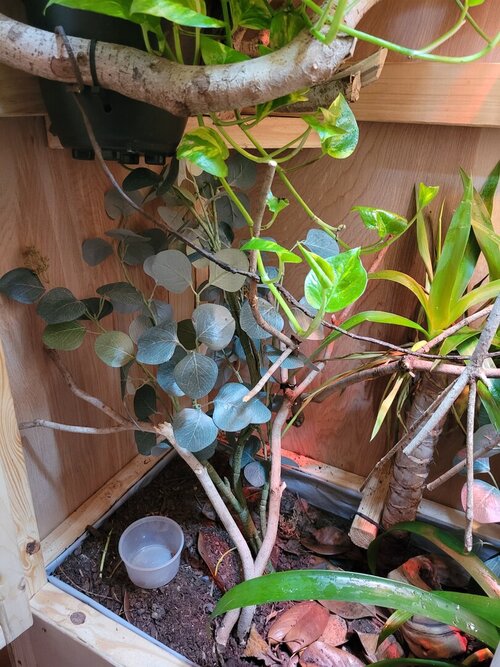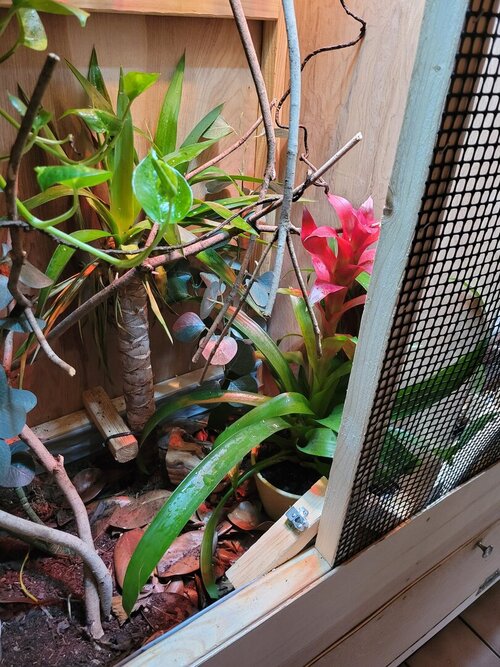Chameleon Info:
Cage Info:
Current Problem - The current problem you are concerned about. Wanting to see how the cage looks, what you think about my husbantry to see if there is anything I need to change/adjust/be concerned about.
- Your Chameleon - The species, sex, and age of your chameleon. How long has it been in your care? Veiled chameleon, female, got her at 6 weeks old from breeder, her name is Pez
- Handling - How often do you handle your chameleon? daily - multiple times a week, depending on her mood
- Feeding - What are you feeding your cham? What amount? What is the schedule? How are you gut-loading your feeders? Dubai roaches, superworms, wax worms, horn worms. She tends to eat between daily and every other day. We typically will feed her about 2 dubai roaches and 1-3 superworms a day. Dubai roaches we breed here, fed vegetables, watered, the babies especially love to eat Fluker's High Calcium cricket diet. Superworms are fed vegetables. Wax worms and horned worms are occasional and fed when we get them.
- Supplements - What brand and type of calcium and vitamin products are you dusting your feeders with and what is the schedule? we daily dust the feeder roaches (once she perks up and we know she is going to eat) with Zoo Med ReptiCalcium + D3 (will use this bi-monthly). We will occasionally dust the superworms with this as well, but it is sometimes hard to guess how much she wants to eat. I need to get the calcium phosphorus free no d3 to add to her daily feeders.
- Watering - What kind of watering technique do you use? How often and how long to you mist? Do you see your chameleon drinking? spray bottle misting live plants, every morning and night, with the bulk of the spraying in the morning, more of a light misting at nighttime. We see her drinking quite often and I will spray a little more when I see her actively getting excited about the water to make sure she gets enough.
- Fecal Description - Briefly note colors and consistency from recent droppings. Has this chameleon ever been tested for parasites? Typically brown and white urates, but the bioactive enclosure cleans that up pretty quickly. Pez had a large dropping yesterday, very large and brown. A little abnormal for her, but I am not sure if that is a big problem or not. Not tested yet, but have a vet visit set up after her sister passed today.
- History - Any previous information about your cham that might be useful to others when trying to help you. We got her at 6 weeks old and have played and held her since the beginning.
Cage Info:
- Cage Type - Describe your cage (Glass, Screen, Combo?) What are the dimensions? homemade cage, made out of wood (back and two sides) and screen (top and front). The dimensions are approximately 6 feet tall, 1.5 feet deep and 5 feet wide, but Pez only has access to the left side of this cage. Her sister had the other side, so they each have 6 feet tall, 1.5 feet deep and 2.5 feet wide.
- Lighting - What brand, model, and types of lighting are you using? What is your daily lighting schedule? We have a Zoo Med ReptiSun T5 hood over the cage, with a Zoo Med ReptiSun 10.0 UVB T5HO 54W 46" bulb.
- Temperature - What temp range have you created (cage floor to basking spot)? Lowest overnight temp? How do you measure these temps? I don't have this recorded, but will determine that today and share my update. We have a temperature/humity reader, but I don't record the levels usually and I don't want to state the wrong temp.
- Humidity - What are your humidity levels? How are you creating and maintaining these levels? What do you use to measure humidity? humidity is around 45-60% depending on when I check, and obviously near the plants the humidity can get higher, near 70%, so it depends on where she is. Creating that by having a bioactive cage, with live plants and misting twice a day at least. Have a temperature/humidity level reader in the cage that we use to measure humidity.
- Plants - Are you using live plants? If so, what kind? yes, pothos/ivy, boston fern, bromeliads
- Placement - Where is your cage located? Is it near any fans, air vents, or high traffic areas? At what height is the top of the cage relative to your room floor? cage is near the front door, as that is where the cage fits for now. There is a walkway there that we use to get to the bedrooms, but we are just a family of four, so it isn't super high traffic, though we are all at home lately, but this is consistant and we've always done this since we have had the chameleons.
- Location - Where are you geographically located? DFW, Texas
Current Problem - The current problem you are concerned about. Wanting to see how the cage looks, what you think about my husbantry to see if there is anything I need to change/adjust/be concerned about.

